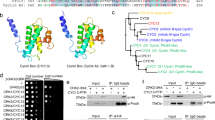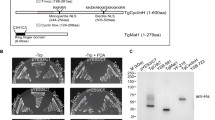Abstract
Regulatory roles of CDKs in fundamental processes including cell cycle progression and transcription are well conserved in metazoans. This family of proteins has undergone significant evolutionary divergence and specialization. Several CDK-like kinases have been identified and characterized in parasitic protozoans. However, clear functional role and physiological relevance of these proteins in protozoans still remain elusive. In continuation with the recent finding that CDK-like protein PfPK5 regulates important DNA replication protein like origin recognition complex subunit 1 in Plasmodium falciparum, here we have discussed the emerging significance of CDK1/2 homologs in DNA replication of parasitic protozoans. In fact, involvement of these proteins in crucial cellular processes projects them as potential drug targets. The possibilities that CDKs offer as potential therapeutic targets in controlling parasite progression have also been explored.

Similar content being viewed by others
References
Aressy B, Ducommun B (2008) Cell cycle control by the CDC25 phosphatases. Anticancer Agents Med Chem 8:818–824
Arnot DE, Ronander E, Bengtsson DC (2011) The progression of the intra-erythrocytic cell cycle of Plasmodium falciparum and the role of the centriolar plaques in asynchronous mitotic division during schizogony. Int J Parasitol 41:71–80
Bell SP, Dutta A (2002) DNA replication in eukaryotic cells. Annu Rev Biochem 71:333–374
Benmerzouga I, Concepcion-Acevedo J, Kim HS, Vandoros AV, Cross GA, Klingbeil MM, Li B (2013) Trypanosoma brucei Orc1 is essential for nuclear DNA replication and affects both VSG silencing and VSG switching. Mol Microbiol 87:196–210
Borgne A, Meijer L (1996) Sequential dephosphorylation of p34(cdc2) on Thr-14 and Tyr-15 at the prophase/metaphase transition. J Biol Chem 271:27847–27854
Bracchi-Ricard V, Barik S, Delvecchio C, Doerig C, Chakrabarti R, Chakrabarti D (2000) PfPK6, a novel cyclin-dependent kinase/mitogen-activated protein kinase-related protein kinase from Plasmodium falciparum. Biochem J 347(Part1):255–263
Deshmukh AS, Srivastava S, Herrmann S, Gupta A, Mitra P, Gilberger TW, Dhar SK (2012) The role of N-terminus of Plasmodium falciparum ORC1 in telomeric localization and var gene silencing. Nucleic Acids Res 40:5313–5331
Deshmukh AS, Agarwal M, Mehra P, Gupta A, Gupta N (2015) Regulation of Plasmodium falciparum origin recognition complex subunit 1 (PfORC1) function through phosphorylation mediated by CDK-like kinase PK5. Mol Microbiol 98:17–33
Doerig C (2004) Protein kinases as targets for anti-parasitic chemotherapy. Biochim Biophys Acta 1697:155–168
Doerig C, Endicott J, Chakrabarti D (2002) Cyclin-dependent kinase homologues of Plasmodium falciparum. Int J Parasitol 32:1575–1585
Doerig C, Billker O, Haystead T, Sharma P, Tobin AB, Waters NC (2008) Protein kinases of malaria parasites: an update. Trends Parasitol 24:570–577
Dorin-Semblat D, Carvalho TG, Nivez MP, Halbert J, Pouller P et al (2013) An atypical cyclin-dependent kinase controls Plasmodium falciparum proliferation rate. Kinome 1:4–16
Findeisen M, El-Denary M, Kapitza T, Graf R, Strausfeld U (1999) Cyclin A-dependent kinase activity affects chromatin binding of ORC, Cdc6, and MCM in egg extracts of Xenopuslaevis. Eur J Biochem 264:415–426
Francia ME, Striepen B (2014) Cell division in apicomplexan parasites. Nat Rev Microbiol 12:125–136
Gerald N, Mahajan B, Kumar S (2011) Mitosis in the human malaria parasite Plasmodium falciparum. Eukaryot Cell 10:474–482
Geyer JA, Keenan SM, Woodard CL, Thompson PA, Gerena L, Nichols DA, Gutteridge CE, Waters NC (2009) Selective inhibition of Pfmrk, a Plasmodium falciparum CDK, by antimalarial 1,3-diaryl-2-propenones. Bioorg Med Chem Lett 19:1982–1985
Graeser R, Franklin RM, Kappes B (1996) Mechanisms of activation of the cdc2-related kinase PfPK5 from Plasmodium falciparum. Mol Biochem Parasitol 79:125–127
Gupta A, Mehra P, Dhar SK (2008) Plasmodium falciparum origin recognition complex subunit 5: functional characterization and role in DNA replication foci formation. Mol Microbiol 69:646–665
Gupta A, Mehra P, Deshmukh A, Dar A, Mitra P, Roy N, Dhar SK (2009) Functional dissection of the catalytic carboxyl-terminal domain of origin recognition complex subunit 1 (PfORC1) of the human malaria parasite Plasmodium falciparum. Eukaryot Cell 8:1341–1351
Halbert J, Ayong L, Equinet L, Le Roch K, Hardy M, Goldring D, Reininger L, Waters N, Chakrabarti D, Doerig C (2010) A Plasmodium falciparum transcriptional cyclin-dependent kinase-related kinase with a crucial role in parasite proliferation associates with histone deacetylase activity. Eukaryot Cell 9:952–959
Holton S, Merckx A, Burgess D, Doerig C, Noble M, Endicott J (2003) Structures of P. falciparum PfPK5 test the CDK regulation paradigm and suggest mechanisms of small molecule inhibition. Structure 11:1329–1337
Houze S, Hoang NT, Lozach O, Le Bras J, Meijer L, Galons H, Demange L (2014) Several human cyclin-dependent kinase inhibitors, structurally related to roscovitine, are new anti-malarial agents. Molecules 19:15237–15257
Jirage D, Chen Y, Caridha D, O’Neil MT, Eyase F, Witola WH, Mamoun CB, Waters NC (2010) The malarial CDK Pfmrk and its effector PfMAT1 phosphorylate DNA replication proteins and co-localize in the nucleus. Mol Biochem Parasitol 172:9–18
Keenan SM, Welsh WJ (2004) Characteristics of the Plasmodium falciparum PK5 ATP-binding site: implications for the design of novel antimalarial agents. J Mol Graph Model 22:241–247
Khan F, Tang J, Qin CL, Kim K (2002) Cyclin-dependent kinase TPK2 is a critical cell cycle regulator in Toxoplasma gondii. Mol Microbiol 45:321–332
Kinnaird JH, Bumstead JM, Mann DJ, Ryan R, Shirley MW, Shiels BR, Tomley FM (2004) EtCRK2, a cyclin-dependent kinase gene expressed during the sexual and asexual phases of the Eimeria tenella life cycle. Int J Parasitol 34:683–692
Kinnard JH, Tait A, Logan M, Kirvar E, Carrington M (1996) Isolation and charecterization of a cdc2-related protein from the bovine protozoan parasite Theileria. Mol Microbiol 22:293–302
Kvaal CA, Radke JR, Guerini MN, White MW (2002) Isolation of a Toxoplasma gondii cyclin by yeast two-hybrid interactive screen. Mol Biochem Parasitol 120:187–194
Le Roch K, Sestier C, Dorin D, Waters N, Kappes B, Chakrabarti D, Meijer L, Doerig C (2000) Activation of a Plasmodium falciparum cdc2-related kinase by heterologous p25 and cyclin H. Functional characterization of a P. falciparum cyclin homologue. J Biol Chem 275:8952–8958
Lee KY, Bang SW, Yoon SW, Lee SH, Yoon JB, Hwang DS (2012) Phosphorylation of ORC2 protein dissociates origin recognition complex from chromatin and replication origins. J Biol Chem 287:11891–11898
Li JL, Robson KJ, Chen JL, Targett GA, Baker DA (1996) Pfmrk, a MO15-related protein kinase from Plasmodium falciparum. Gene cloning, sequence, stage-specific expression and chromosome localization. Eur J Biochem 241:805–813
Mailand N, Gibbs-Seymour I, Bekker-Jensen S (2013) Regulation of PCNA-protein interactions for genome stability. Nat Rev Mol Cell Biol 14(5):269–282
Makise M, Takehara M, Kuniyasu A, Matsui N, Nakayama H, Mizushima T (2009) Linkage between phosphorylation of the origin recognition complex and its ATP binding activity in Saccharomyces cerevisiae. J Biol Chem 284:3396–3407
Mancio-Silva L, Rojas-Meza AP, Vargas M, Scherf A, Hernandez-Rivas R (2008) Differential association of Orc1 and Sir2 proteins to telomeric domains in Plasmodium falciparum. J Cell Sci 121:2046–2053
Mehra P, Biswas AK, Gupta A, Gourinath S, Chitnis CE, Dhar SK (2005) Expression and characterization of human malaria parasite Plasmodium falciparum origin recognition complex subunit 1. Biochem Biophys Res Commun 337:955–966
Merckx A, Le Rosh K, Nivez MP, Dorin D, Alano P, Gutierrez GJ et al (2003) Identification and initial characterization of three novel cyclin-related proteins of the human malaria parasite Plasmodium falciparum. J Biol Chem 278:39839–39850
Mitra P, Banu K, Deshmukh AS, Subbarao N, Dhar SK (2015) Functional dissection of proliferating-cell nuclear antigens (1 and 2) in human malarial parasite Plasmodium falciparum: possible involvement in DNA replication and DNA damage response. Biochem J 470:115–129
Moldovan GL, Pfander B, Jentsch S (2007) PCNA, the maestro of the replication fork. Cell 129(4):665–679
Remus D, Blanchette M, Rio DC, Botchan MR (2005) CDK phosphorylation inhibits the DNA-binding and ATP-hydrolysis activities of the Drosophila origin recognition complex. J Biol Chem 280:39740–39751
Roques M, Wall RJ, Douglass AP, Ramaprasad A, Ferguson DJ, Kaindama ML, Brusini L, Joshi N, Rchiad Z, Brady D et al (2015) Plasmodium P-type cyclin CYC3 modulates endomitotic growth during oocyst development in mosquitoes. PLoS Pathog 11:e1005273
Ross-Macdonald PB, Graeser R, Kappes B, Franklin R, Williamson DH (1994) Isolation and expression of a gene specifying a cdc2-like protein kinase from the human malaria parasite Plasmodium falciparum. Eur J Biochem 220:693–701
Striepen B, Jordan CN, Reiff S, van Dooren GG (2007) Building the perfect parasite: cell division in apicomplexa. PLoS Pathog 3:e78
Treeck M, Sanders JL, Elias JE, Boothroyd JC (2011) Thephosphoproteomes of Plasmodium falciparum and Toxoplasma gondii reveal unusual adaptations within and beyond the parasites’ boundaries. Cell Host Microbe 10:410–419
Vas A, Mok W, Leatherwood J (2001) Control of DNA rereplication via Cdc2 phosphorylation sites in the origin recognition complex. Mol Cell Biol 21:5767–5777
Wang SC, Nakajima Y, Yu YL, Xia W, Chen CT, Yang CC, McIntush EW, Li LY, Hawke DH, Kobayashi R, Hung MC (2006) Tyrosine phosphorylation controls PCNA function through protein stability. Nat Cell Biol 8:1359–1368
Ward P, Equinet L, Packer J, Doerig C (2004) Protein kinases of the human malaria parasite Plasmodium falciparum: the kinome of a divergent eukaryote. BMC Genom 12:79
White MW, Radke J, Conde de Felipe M, Lehmann M (2007) Cell cycle control/parasite division. Horizon Scientific Press, Norwich
Woo RA, Poon RY (2003) Cyclin-dependent kinases and S phase control in mammalian cells. Cell Cycle 2:316–324
Woodward CL, Li Z, Kathcart AK, Terrell J, Gerena L, Lopez-Sanchez M, Kyle DE, Bhattacharjee AK, Nichols DA, Ellis W et al (2003) Oxindole-based compounds are selective inhibitors of Plasmodium falciparum cyclin dependent protein kinases. J Med Chem 46:3877–3882
Acknowledgments
Authors acknowledge DST-PURSE, DBT-Builder, DBT-CoE in Parasitology and UGC-SAP for funding and thank Sabyasachi Pradhan for his assistance with designing the model. Meetu Agarwal acknowledges CSIR, India, for fellowship. Abhijit S. Deshmukh acknowledges the Department of Science and Technology, India, for INSPIRE fellowship.
Author information
Authors and Affiliations
Corresponding author
Additional information
Communicated by M. Kupiec.
A. S. Deshmukh and M. Agarwal contributed equally to this review.
Rights and permissions
About this article
Cite this article
Deshmukh, A.S., Agarwal, M. & Dhar, S.K. Regulation of DNA replication proteins in parasitic protozoans: possible role of CDK-like kinases. Curr Genet 62, 481–486 (2016). https://doi.org/10.1007/s00294-015-0562-2
Received:
Revised:
Accepted:
Published:
Issue Date:
DOI: https://doi.org/10.1007/s00294-015-0562-2




